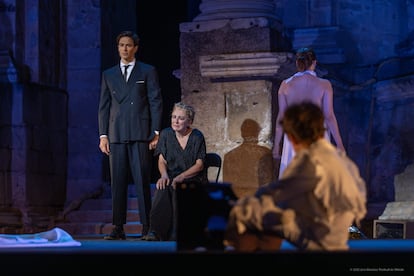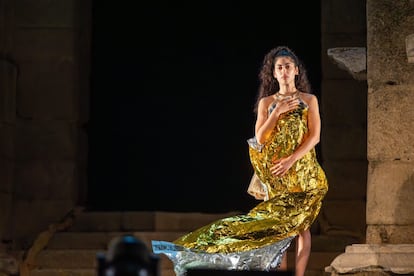'The Trojan Women': The eternal tragedy of women crushed by war is repeated

In the stands of Mérida's Roman theater, the fans are waging their own battle. Thousands of people wave their contraptions, trying unsuccessfully to cool off on a night of sweltering heat. On stage, however, the war is already lost. The great Troy has fallen, and its women, stripped of wealth and family, await their fate in a lottery. This is the story of The Trojan Women , the famous text by Euripides that Carlota Ferrer premiered this Wednesday at the Mérida Classical Theater Festival, with a free and contemporary version starring Isabel Ordaz, with whom Ferrer also co-wrote the script, and Mina El Hammani . The optical noise of the fans will soon be drowned out by a jumble of visual stimuli that will parade across the stage with the intention of lending a contemporary meaning to the ancient text.
This isn't the first time Euripides' eternal classic has graced the Mérida stage, nor the first time it's been interpreted in a completely contemporary way. In 2017—the closest precedent within the festival— Carme Portaceli offered a version that moved the action to the Syrian war , recreating the devastated city of Aleppo on stage and filling the stage with corpses wrapped in white blankets. Carlota Ferrer's new production avoids any explicit parallels with current conflicts, but it's inevitable—as the creative team admits—to think of the Gaza Strip . The tragedy of the Trojan women, women who, after the fall of their city and the death of their husbands, sons, and grandchildren, were left at the mercy of the victors to be drawn by lot, tortured, raped, and enslaved, is the story of all the defeated: that of a truncated childhood, a forced exodus, the senselessness of war that sheds its epic spirit to reveal its rawness. And in these times—how many years has that phrase been repeated—it takes on special meaning. The multifaceted Ferrer—also responsible for the set and costume design—envelops the work in a contemporary visual and audio language, while preserving intact the core of a text that, more than 2,500 years later, continues to speak to the present. “We looked for testimonies from both Ukraine and Gaza to see how the women spoke on camera and described what was happening, and I realized it was very similar to what Euripides had already said,” the director acknowledged minutes after the premiere.

The show opens with a textless prologue in which the characters, dressed as classic Trojans, seem to emerge from a relief capturing a moment from the Battle of Troy. It's all movement and sound, a kind of brief dance that, without blows or combat, reconstructs the conflict. But this is the only moment when classic and archetypal Trojans take to the Mérida stage; from there, Ferrer deploys her signature arsenal of visual and audio resources: projections, music, sound effects, dance, and even the introduction of a character singing, microphone in hand, like a rock star, sometimes all simultaneously. An exercise in audiovisual poetics , "strange things that emerge from intuition," she says, that challenges the viewer and aims to "add and permeate the skin" without diverting attention from the text.
The truth is that this is a work that enters, above all, through the eyes, and it is in its visual constructions that it finds a contemporary interpretation. There is no scenery other than the imposing backdrop of Roman columns flanked by two tents on the sides that serve as the characters' entrance and exit. It is the actors who, through various choreographies, fill the enormous space during the scenes. The chorus of Trojan women is reduced to a small group of faceless, voiceless women with a number on their backs, reminiscent of modern-day prisoners; the Greek soldiers wear camouflage clothing and balaclavas; and Talthybius, the Greek herald who carries an arsenal of dire news throughout the play, is a clumsy diplomat in a suit.

The main challenge, the director explains, was to make "this a production with human beings, not archetypal characters." That's why the actors also shed the grandiosity and declamation of the classic text and present sometimes more restrained and grounded performances, even though all this entails "the risk of being swallowed up by the stones of the theater." The rhythm and tone of the play are set by Isabel Ordaz, who plays Queen Hecuba and barely leaves the stage during the performance's just over 90 minutes. With her character, Ordaz evokes a modern-day grandmother, mother, or mother-in-law, but, with explosive moments, she remains the powerful Trojan Queen of antiquity. The absence of a chorus in this version gives Hecuba, who speaks many of her lines, an additional central role.
Mina El Hammani, although she comes onto the stage late in the performance, plays the important role of Helen, Menelaus' wife and indirect cause of the Trojan War. The rest of the cast is completed by Cristobal Suárez as Taltibio; María Vázquez as Cassandra; Esther Ortega as Andromache; Abel de la Fuente as Astyanax, Andromache's son—and also Ortega's son—; and Carlos Beluga as Menelaus, the king of Sparta. All of them, in addition to embodying their characters, consistently take to the stage to fill the space with choreography while representing soldiers or Trojan women. Selam Ortega, Ana Erdozain, and Alba González also contribute movement, without specific roles.
As the show draws to a close, the heat doesn't subside, but the fans no longer dance as much. The space that Hecuba inhabited for nearly two hours suddenly becomes a beach filled with joyful vacationers. There are no more Trojan women, no more Trojan men, no more ruins, only the inert, lifeless body of that woman who was once queen and now camouflaged among the bathers. "Exodus," reads a projection on the columns. Nor is there any memory of what once was. The work's relevance summed up in one scene, the silence is broken by applause.
EL PAÍS
